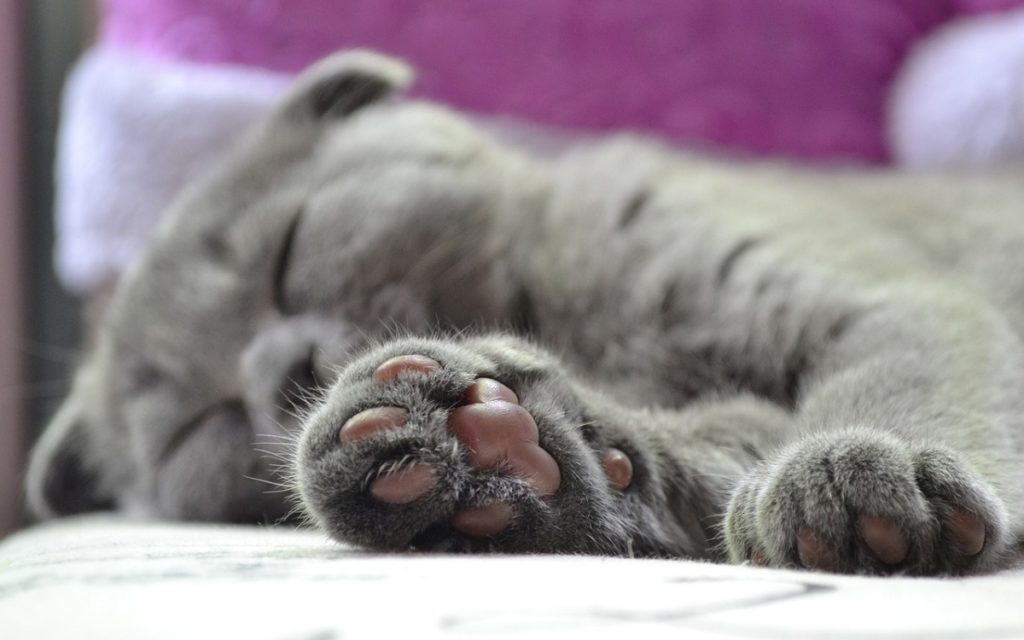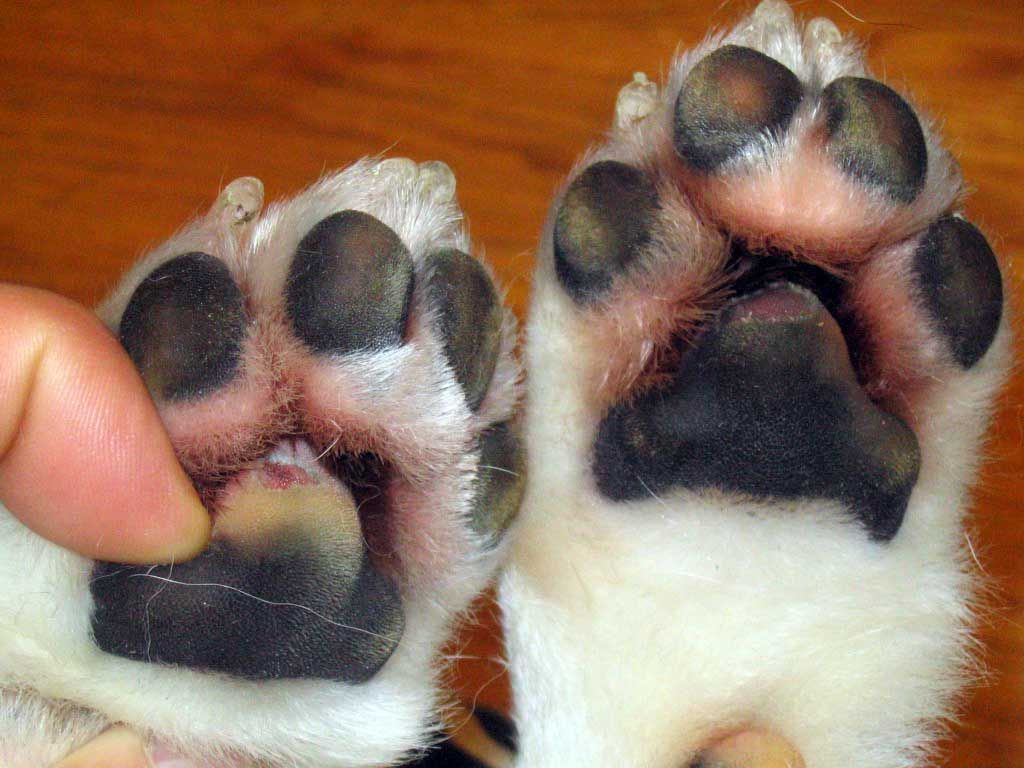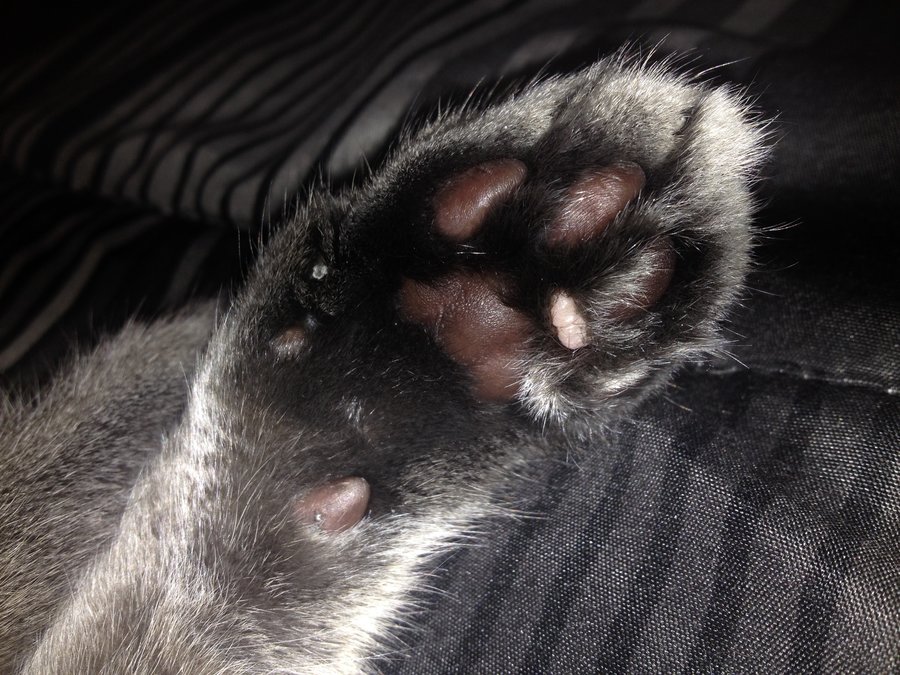Don’t you just love when your kitty randomly gives you a “paw-five”? Or how beautiful she looks when she stretches her little paws while yawning?
There’s no doubt that cat paws are vital for the feline anatomy. Just like humans rely heavily on their hands, cats equally use their paws to do a whole lot.
A cat’s paw pads may be tiny but they can tell you a lot about the health of your pet.
When you notice anything amiss such as a change in color, it could mean that your pet is suffering from a medical condition
. Paw pads turning pink from the blues are a result of several issues. We have discussed them below and what to do about them.
1. Pododermatitis

Also called pillow foot, pododermatitis is the inflammation of a kitty’s paw pads. The name comes from the pillow or balloon shape of the inflamed pads.
It is essentially caused by bacterial, fungal, and parasitic infections. Besides infections, pododermatitis can also be caused by poor grooming, cancer, low thyroid levels, and environmental irritants.
When an otherwise healthy feline changes her paw pads’ color to pink or purplish, she may have pillow foot.
As microbes attack the pads, the plasma cells will produce antibodies to fight the infection.
If the cells are produced in excess, they will trigger swelling, discharge, solid masses, and redness around the paw pad tissue.
You can tell your cat has pillow feet if her pads change color and puff out like a pillow.
The infection typically affects more than one foot without causing much pain.
What to do
If you observe these symptoms, the only thing to do is to take the cat to the vet for diagnostic tests.
The condition is diagnosed by a blood test. The high levels of antibodies and lymphocytes will show in his blood.
To treat it, the vet will administer strong antibiotics for several months.
2. Vitiligo
Feline vitiligo has also been shown to cause a cat’s paw pads to turn pink.
Simply put, this is a depigmentation of the kitty’s skin tissue. Unlike pigmentation where the skin color darkens, vitiligo causes the skin to take on a lighter color.
In the case of cats, the condition can cause pads to turn light pink. Besides the paw pads, the color change can also affect the kitty’s nose, anus, and mouth.
Vitiligo is caused by issues in the production of melanin – the pigment that gives your pet its skin color. These range from stress, autoimmune diseases, hereditary causes, and neurological diseases.
Once depigmentation starts, it will keep spreading for about 3-6 months. Different cats experience the condition differently. When it’s over, the condition will no longer spread.
What to do
Hereditary vitiligo is mainly harmless. It is neither painful nor deadly for your adorable kitty. Still, you want to talk to your vet about it.
However, if it is triggered by a painful medication condition, it can cause issues for the cat.
In case her immune system is attacking itself or she’s stressed, she will need medical help to correct the issue.
Once the root cause is dealt with, depigmented areas will go through pigmentation again and will return to their initial color.
However, there’s no guarantee that repigmentation will take place. Nevertheless, let the vet check your kitty and advise accordingly.
3. Vitamin Deficiency
Vitamin C has multiple roles in the feline body. It is utilized in tissue growth and maintenance, immune regulation, amelioration of oxidative stress, and, of course, skin pigmentation.
Too little of it can cause a lack of pigmentation. Under normal circumstances, most cats produce enough of the vitamin for good pigmentation. However, as they age, its supply dips causing deficiencies.
On other hand, over-supplementation can also lead to the deficiency of other important minerals such as phosphorous, zinc, and iron. Each of these is needed in the right proportions.
What to do
If your kitty is advanced in age, she may need a good vitamin C supplement to take care of depigmentation.
Contact your vet to get the proper dosage for your cat. They are likely to carry out tests to know how much the pet needs.
In case you suspect that there’s an imbalance of minerals and vitamins offered to the cat, a trip to the vet will also sort you out.
4. Injury

A change in your cat’s paw pads can be caused by injury as well.
Your kitty uses her toe beans to do just about anything. She grooms herself with them, walks on them, grabs onto prey with them, the list goes on.
Sometimes, the little pads come in contact with sharp objects, bites from other animals, ingrown nails, sulfur, and fire.
An injured paw pad is likely to turn pink or black if there’s a blood clot around it.
Along with changing color, an injury may have a puncture wound, overgrown or ingrown nail embedded in it, a blister, an inflammation, cracked or peeling skin, and visible cuts.
If the injury is deep, your cat will limp and possibly have bleeding. She may also lick her feet, and run a fever.
What to do
Paw pad injuries are not to be ignored. Even if your cat isn’t showing severe symptoms, she deserves medical help.
In case she has a foreign object lodged in her pads, the vet will remove them and clean the wound with an antiseptic.
Deep cuts may need suturing and dressing to keep them infection-free.
5. Infections
Besides an injury, an infection in the paw can also cause the color to turn pink. Infections can be caused by anything.
Pets that have allergic reactions can lick and bite the paw pads to the point of puncturing the skin.
Exposed skin invites all kinds of microbes that can trigger inflammation. Dry and cracked paws can also put your cat at the risk for the same.
Most importantly, bacterial, viral, and fungal infections in the paw pads can grow out of control and give rise to infections.
What to do
While infections are easy to treat with antibiotics, you don’t want to self-administer anything.
Without the right equipment and skill, you will not know the specific cause of the problem.
The vet will need to carry out tests to know which microorganism is responsible before treating it. Head over to the pet clinic with the kitty right away.
Parting Thoughts
A change in your cat’s paw pads is enough reason to visit the professionals. Her body is screaming that something is not okay somewhere. It could be any of the above causes. The best thing to do is to let the experts take a look at your kitty.

Hi! I am Eleanor Price. I started this website after my cat, Louie, almost died from a case of botulism (a type of food poisoning often caused by bacteria that grow on food items). Turned out that my cat’s diet was the problem. I have made it my duty to provide the best information and recommendations about everything cat lovers need to know about their felines’ health and wellbeing. My goal is to find the most informative content on anything feline-related and share it with fellow hardworking kitty lovers.

